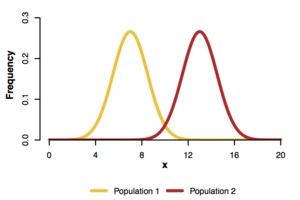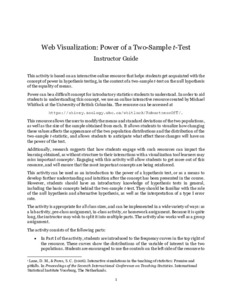
Web Visualization: Power of a Two-Sample t-Test
(0)In this activity, students use an online interactive resource to develop an intuition about the power of a hypothesis test in the context of a two-sample t-test.
Prerequisite Knowledge
- Recognize that the two-sample t-test uses data from two independent samples to test whether two populations have equal means
- Describe the role of the null hypothesis and the alternative hypothesis in a hypothesis test
- Interpret the type I error rate of a hypothesis test
- Be familiar with the Normal distribution, including the roles of its two parameters
Learning Objectives
- Explain the concept of power in the context of a two-sample t-test
- Summarize how the power of a two-sample t-test is affected by the difference in the two population means, the standard deviations of the two populations, and the sizes of the samples obtained from the two populations
- Develop an intuition for why the above three factors affect the difficulty of detecting a difference in the two population means
- Use an online interactive resource to determine the required sample size for obtaining a desired value of the power
- Describe the connection between the power and the type I error rate of a hypothesis test
Description
This activity is based on an interactive online resource created by Michael Whitlock at the University of British Columbia (http://shiney.zoology.ubc.ca/whitlock/RobustnessOfT/). The goal of this activity is for students to develop an intuition about the power of a hypothesis test, in the context of a two-sample t-test. Students are prompted to set various values for the means and standard deviations of the two population distributions, and the size of the sample obtained from each. The resource allows them to visualize how changing these values affects the appearance of the two populations and the distribution of the two-sample t-statistic, and allows students to anticipate what effect these changes will have on the power of the test.
Suggested Uses, Tips and Discoveries
This activity can be used as an introduction to the power of a hypothesis test, or as a means to develop further understanding and intuition after the concept has been presented in the course. However, students should have an introductory knowledge of hypothesis tests in general, including the basic concepts behind the two-sample t-test.
The activity is appropriate for all class sizes, and can be implemented in a wide variety of ways: as a lab activity, pre-class assignment, in-class activity, or homework assignment. Because it is quite long, the instructor may wish to split it into multiple parts. The activity also works well as a group assignment.
Creator
- Isberg, Sonja
Resource Type
Date Approved
Access
Everyone
Exercise sheet for students
code
https://statspace.elearning.ubc.ca/handle/123456789/331

Comments
Ratings in detail